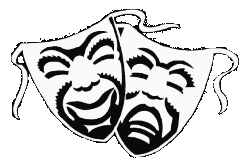

|
Photo Gallery Archive
|
(Reverse chronological order is employed so that photos
of the most recent events will be displayed first.)
Les Miserables
Citadel Players
Spatz Theatre
Halifax, Nova Scotia
April, 2011
For this show, all wash lights were 1000-watt, PAR 64
wide floods in short-throw fixtures. The front used four
fixtures per colour; the rear used two and were barndoored.
All fresnels were 1000-watt, 150mm with barn doors. Other lights
will be specified in the naratives accompanying their photos.
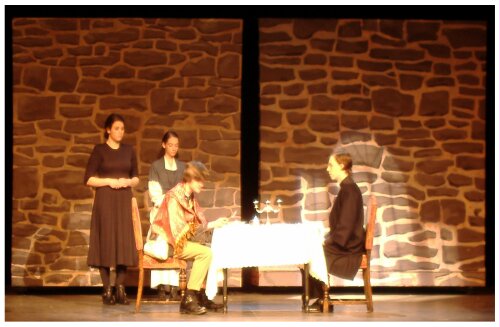 Two 575-watt, 115mm ellipsoidals with 19-degree spreads shine from the front of house (FOH) on to the table area. Light from a church window projects on to the set from a single 19-degree, 1000-watt, 150mm ellipsoidal with a "French Doors" pattern. It is just above and behind the proscenium in order to achieve a high angle. All are white (no colour). To add colour contrast, a dirty peach front wash is used as seen on the stone walls. This illustrates the techniques of layering, separation and colour contrast. By using multiple fixtures from various angles and with some colour, some areas can be highlighted while others are shielded from, or overpowered by, some of the lights. This is an important skill because it focuses audience attention while achieving contrast and a three dimensional look. It makes up for the fact that there is zero back lighting at all in this scene. Otherwise, with no back light, a very flat (dull) look would have been seen. |
 A deep blue front wash covers the stage while the same two center ellipsoidals as above form a pool around Cosette. |
 Medium red plus a bit of the peach washes provide the main colour here. To brighten that up, six 750-watt, 200mm ellipsoidals are used to form three pools across the stage. These sport a warm colour-correction gel and are hung just outside the proscenium to get steeper angles. To highlight the downstage center, the no-colour, FOH ellipsoidals are again used. A brighter, contrasting flesh back wash adds more warmth. |
 The night scene here is lit from behind in extra-dark steel blue. Its fixtures' barndoors may be seen at the top. Front lighting consists of dimmed stage left and right pools in warm colour correction from the 200mm ellipsoidals. To dress this scene, two 37-degree ellipsoidals project different foliage patterns, one on to each side-leg curtain in a light straw colour, while a 19-degree ellipsoidal throws a full moon on to the black, pleated curtain at the extreme upstage. All projection fixtures used are 150mm with 1000-watt lamps. |
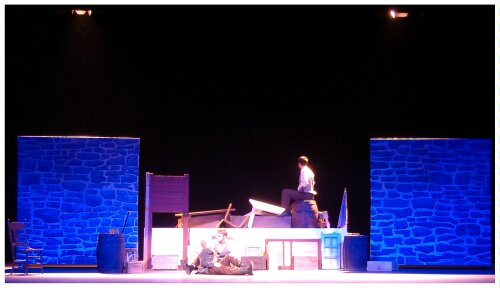 The deep blue wash and center white is again used here for a solem scene at night. A dim backwash in flesh highlights the barricade and lone sentry on top. |
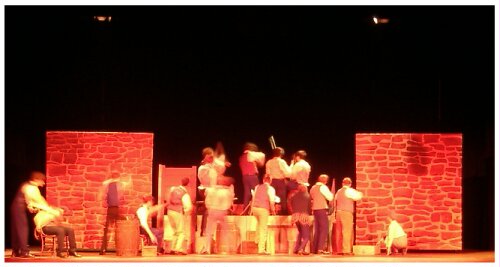 The full front red wash is used to represent the blood of battle. Four other lights from separate angles are used to flash white light on to the barricade to represent gun fire. Three 115mm ellipsoidals and one 150mm PAR were spread around the lighting grid for this. These "flash" lights all had 575-watt lamps and used no gel. Again the back flesh highlighted the barricade from above and behind. For extra light while Jean releases Javere at your left, the six 200mm ellipsoidals were brought up enough to add a yellow cast to the area downstage of the barricade. |
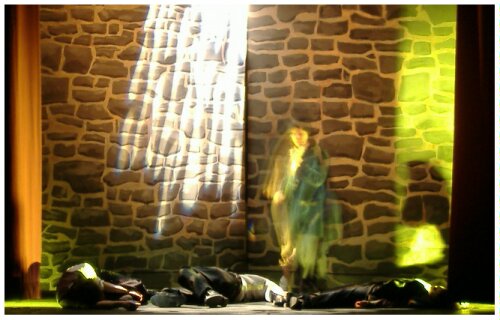 For the sewer scene, the curtains were closed to only reveal the downstage center area. The flats were placed at angles to one another and brought downstage to almost meet the curtains. Lighting is from two 1000-watt, PAR 64 Medium Floods in light green placed on floor bases at the entreme downstage proscenium corners. From the inside proscenuim two 1000-watt, 26-degree 150mm ellipsoidals project sewer grates on to the top of the actors and on to the rear stone wall. To add a touch of face light, a 75-watt, PAR 38 fixture was clamped to the orchestra pit railing at a low angle and pointed up. It can be seen as a dull incandescent glow on the stone walls. Except for the side floor lights, no fixtures have colour. |
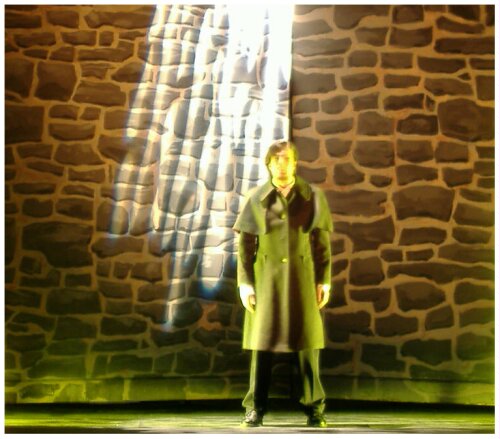 A closeup of the above look. |
 Lighting here is very simple. The extra-dark steel blue back/top lights the ghosts while the FOH center ellipsoidals illuminate the table. In addition, a single 36-degree, 115mm ellipsoidal backlights the table in colour-correction blue. This is a lighter blue than the steel. |
 The pink look here is done by combining the front red and blue washes and by using two 115mm ellipsoidals to throw pink slashes on to the rear black curtain - one each at the extreme upstage left and right positions. The table highlight is from two 200mm ellipsoidals in a warm colour correction (which looks white here to the camera), while the FOH center spots cover the downstage center area in white. A top wash in lavender comes from four fresnels mounted on the center pipe above the stage. These cover the entire downstage area. |
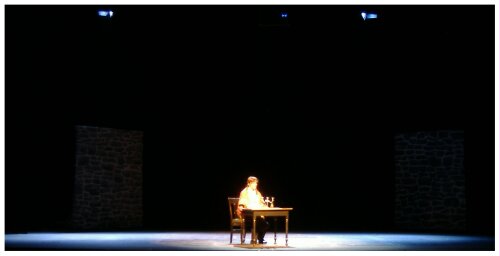 This is the same lighting for the "Ghosts" scene but as seen on an almost empty stage. This accentuates the loneliness of the character at this time. |
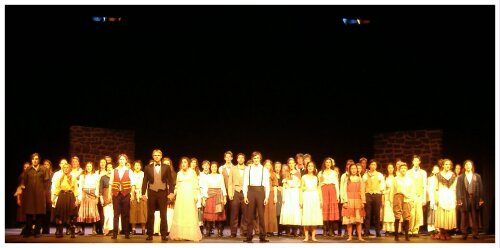 Lighting consists of the front peach and red washes, and the rear flesh and steel blue washes. To punch this up all FOH and proscenium ellipsoidals are on. |
Little Shop of Horrors
Spartan Players
Keating Hall
Dartmouth, Nova Scotia
December, 2010
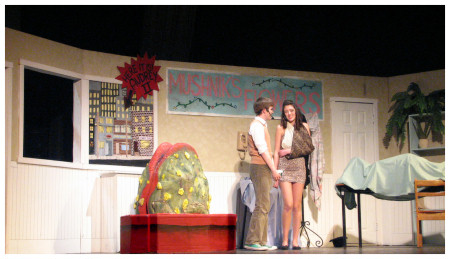 Lighting here consists of four, 500-watt PAR 64 medium floods in a straw colour from the front of house. Backlighting is from a single 500-watt, 150-mm fresnel in steel blue. Not evident, but also on are two doorway lights. They are 500-watt fresnels; one is in steel blue for the exterior doorway and window to the left, while behind the interior door at the right is lit in chocolate. |
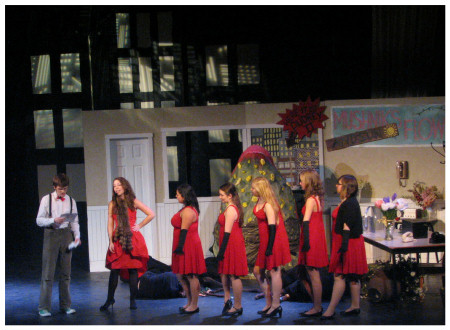 The same set is lit as above, but dimmed down. Added to this is a colour-correction blue from the front of house using 1000-watt, PAR 64 wide floods in short-throw fixtures. As well, a cityscape is projected behind on to the set and black, rear walls of the stage. This is done via two, 500-watt, 35-degree ellipsoidals with no colour. Backlighting in violet is done with three 500-watt, PAR 56 fixtures using medium flood lamps. |
 Here, the set is in colour-correction blue. The chorus and dentist are lit by two 150-mm, 400-watt fresnels from the front in a flesh colour. Backlighting is the same three violet PAR 56s as above, plus a 500-watt fresnel in steel blue hits the girls from their upper left. These latter fixtures may be seen at the top of the photo. The fresnel is second from your left. Its lower barndoor is illuminated by the light. The other three fixtures are the PAR 56s. The cityscape projection is more evident here. |
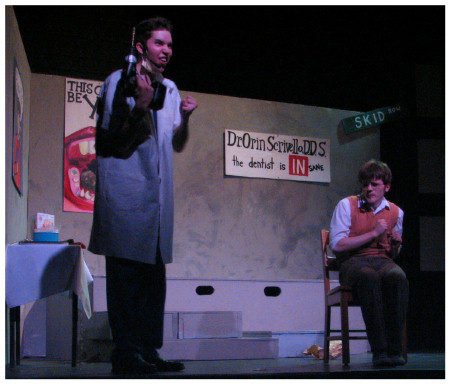 Two 500-watt, medium-flood, PAR 64s in lavender from the front of house and the same fresnel as in the previous photo are all that lights this scene. |
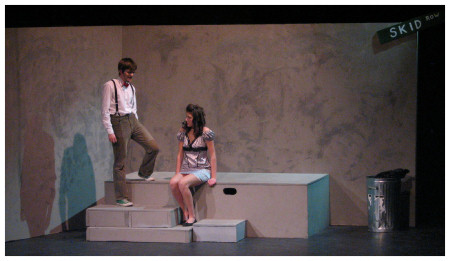 The only lighting for this subtle look is from two 500-watt fresnels. The front one is high overhead on stage and to your right of the actors. Its colour is flesh. The steel blue comes from your right side, but is upstage of the actors. Seymore's shadow is cast by both lights on to the stage-right set wall. One has been coloured by the flesh fresnel, while the shadow cast by this flesh fresnel has been coloured by the steel-blue light. This simple setup illustrates the technique of using the strategic positioning of minimal fixture numbers to cast shadows so as to impart more form and depth to a sparse stage setting. |
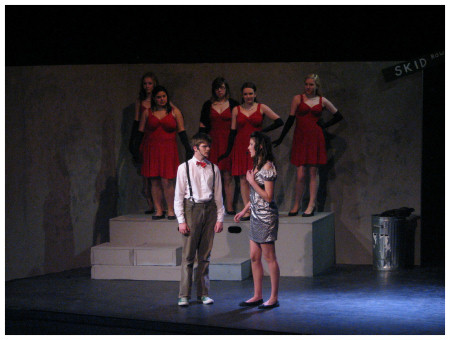 The previous lighting has now been dimmed for the chorus which now occupies the upstage position. The two flesh fresnels from the front are brought up to highlight the downstage position of the principal actors. The rear violet has been added to round out the look. |
 Lighting is a medium blue from the front with a hint of flesh fresnels. Backlights are in violet. |
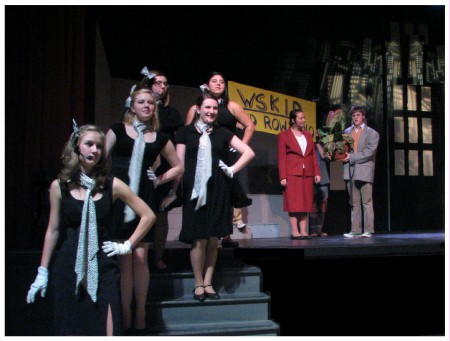 This look is the same as the first "Dentist" photo except that the colour-correction blue has been removed from the stage and added to the chorus girls. Some of the flesh fresnels for the interview area encroaches on the girls on the upper steps. This could have been eliminated but economy of dimming meant the extra lights required could not be used. The result was that existing lights had to do multiple duty and so compromises of coverage were made. |
 Lighting is the same as seen in the first Flower Shop set. Note the dormant tentacle puppeteers in black. Not visible here, they also sport black cloth hoods that cover their heads and faces. |
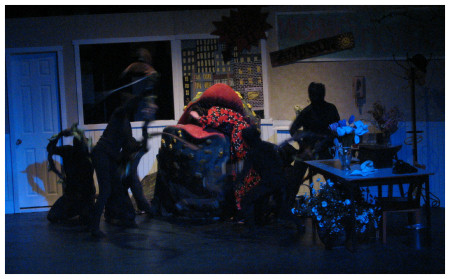 Audrey II begins to eat Audrey and the tentacles come to life. Lighting is the front medium blue. On the plant are a high angle, 500-watt, on-stage fresnel in straw, plus a high angle steel blue fresnel from behind. |
 The Finale. A combination of the previous looks is seen. |
The Fantastics
Dartmouth Players
Dartmouth, Nova Scotia
November, 2010
 A shot taken during rehearsal shows Richard in front of the "Fantasticks" banner which hides a platform. The only lights on are two, 80mm, 250-watt fresnels hung just in front of and above the banner. Their colour is gold, but it looks dull here because the lights are dimmed down so much. |
The main set consists of a central platform one-half step
above the main stage. It is defined by floor-to-ceiling
poles, each of which has a 80mm fresnel at the extreme
top. The front two are in gold, while the rear use a
medium steel blue. An additional two fresnels in gold
are out in front and off to the sides, but within a
metre of the platform. Positioning the fixtures
close in makes for a more intimate feeling.
All lights have been barndoored.
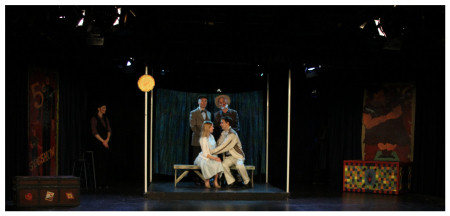 A general view of the set shows the platform. You can see the warm and cool colours defining the actors. The Mute at stage right stays in the shadows. She and the trunk at stage left are lit dimly by 150mm, 500-watt fresnels in a flesh colour. Backlighting these side areas are the same types of fixtures, but with a colour-correction blue. |
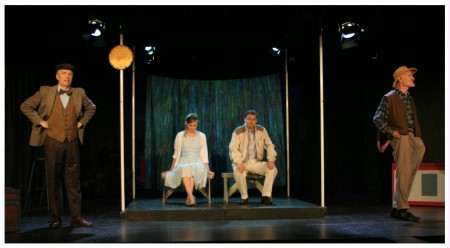 One may now see the effect of the same lighting but brought up to a higher intensity... |
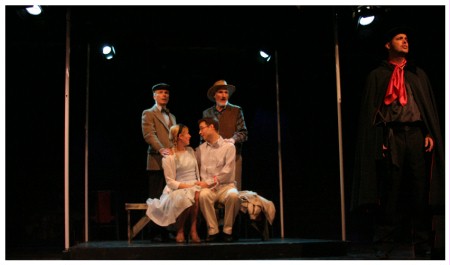 ...and now with the front lights dimmed to where their colours take on much warmer tones. |
 This is the same lighting as above. Dimming the front even more accentuates the backlighting as seen on the Mute, the benches and the stage floor. |
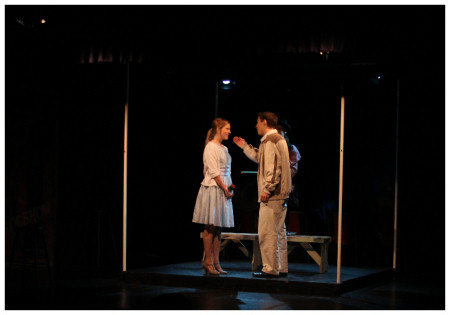 Bringing up the front platform lighting gives a brighter, but still intimate look. |
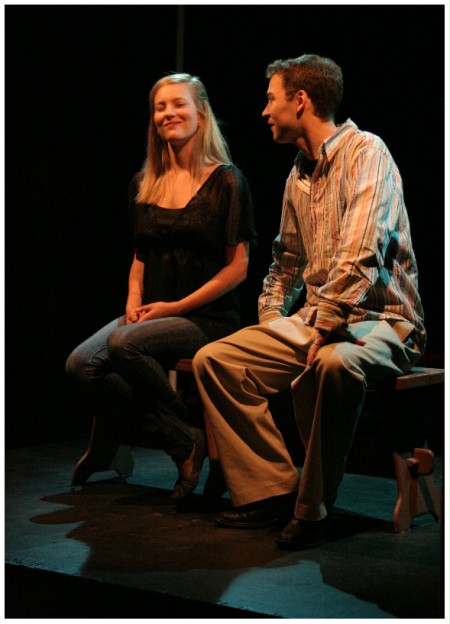 This close-in photo taken during a costumeless rehearsal allows one to see how the lights give form to the actors. The back blue contrasts nicely with the warm front. Notice how this back blue gives form to the male lead by lighting even the underside of his right arm. Without it, areas not "seen" by the front lights would disappear into shadow. See how well this technique works in the next photo with the actors' actual costumes. |
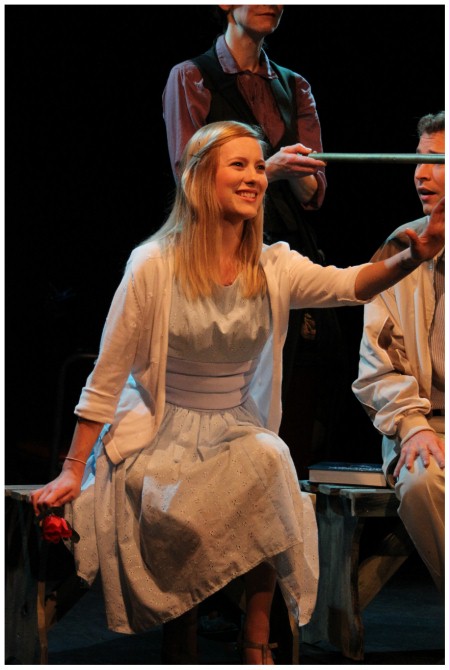 |
 This is a similar look, but the cast is now at the extreme downstage center. The only front lighting is a single, 500-watt fresnel in flesh. It is positioned directly out front and fully lights the Mute's torso and head, but only the faces of Luisa and Matt. It appears reddish here because it is so low in intensity. To the latters' extreme sides and above are two 80mm fresnels, one to each side in a cold steel blue. They have been positioned and barndoored so as to keep the light on the seated actors. Note the excellent separation between them and the Mute despite the Mute's close proximity. The shiny material is mylar `rain' dropped by the Mute. It catches the light despite the low number of fixtures and reduced intensity. |
To achieve a night look, three 150mm, 500-watt fresnels
in a medium blue illuminate the stage from directly out
front. Backlighting is as already described: two fresnels
for the platform, one each for the side areas. The former
in a medium steel blue, the latter, a colour correction blue.
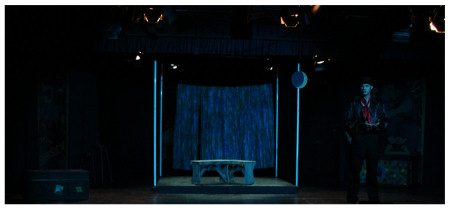 |
 |
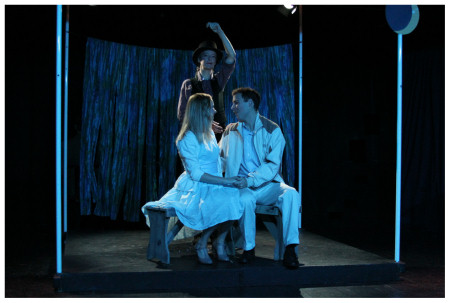 |
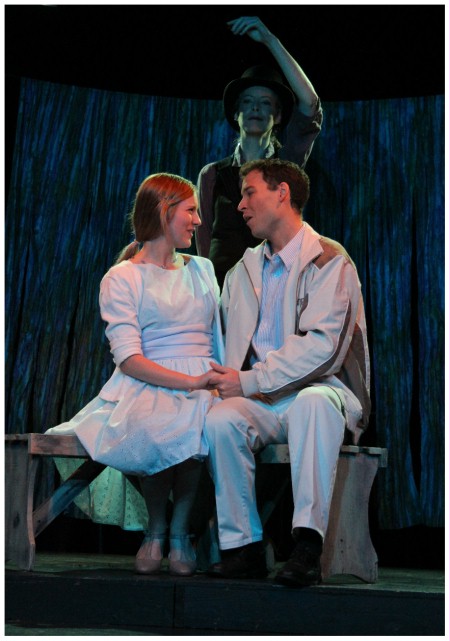 This shows the same lighting but with an additional warm colour on the principals. See how fixture colouring and positioning combine to accurately define the actors, their costumes and the setting, while still establishing the mood of the scene. Note also the separation between the principals and The Mute even though The Mute is immediately upstage of the seated actors. |
Two men emerge from a trunk and after conferring with El Gallo,
later stage the abduction of Luisa. When it starts, the lighting
slowly changes from a bright stage to that of only red plus the
backlighting on the platform. This is seen in the sequence of
photos starting with the second. The reds are done with 150mm,
500-watt fresnels on floor bases at the extreme downstage left
and right. They are barndoored to focus the light only downstage.
 A single 150mm, 500-watt fresnel in red illuminates the trunk opening. It is almost directly above. A second fresnel from front of house lights the area in front. It has a flesh gel but appears reddish here due to the light's low intensity. |
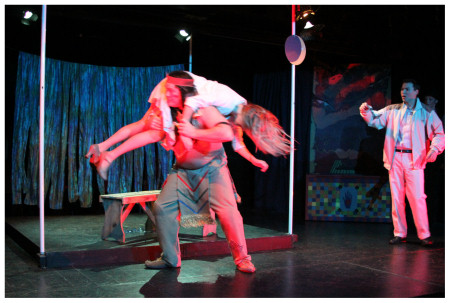 |
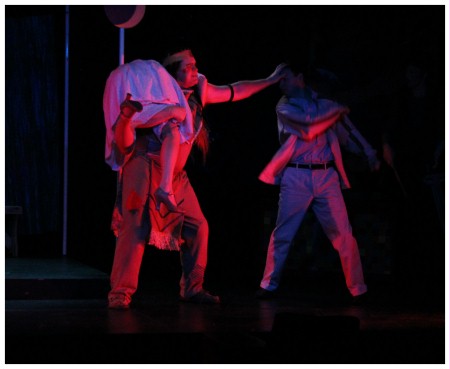 |
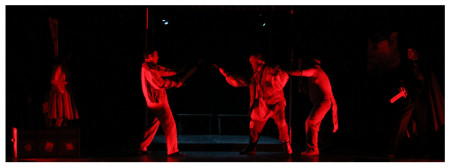 The low position of the red fresnels casts shadows that work well for a fight sequence. These change as the actors move about so as to create a less natural feeling and give additional action to an already active scene. |
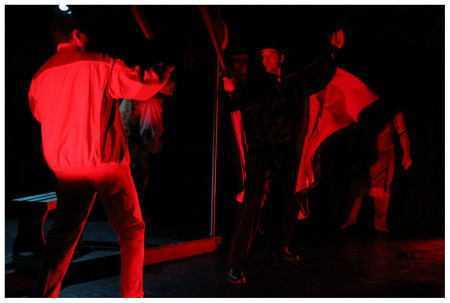 |
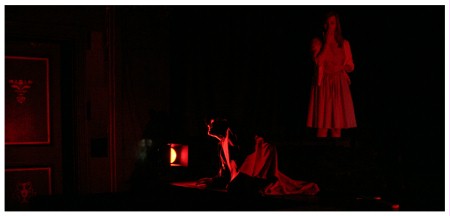 One can see the low position of the stage-right red fresnel. The effect of the stage-left light is seen on Luisa. By the time the light reaches her side of the stage it is able to extend up to above head level. (The door seen at your left is a theatre exit.) |
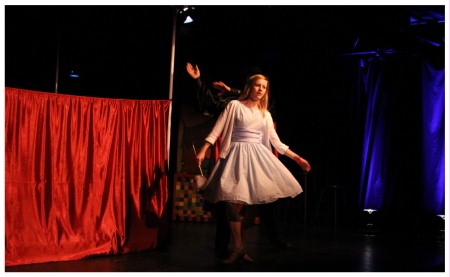 The addition of floor lighting on to the side curtains is seen here. 500-watt fresnels on floor bases with a rich, deep blue shine directly up the pleats. Note again, the separation of each element on stage by careful fixture placement and control of spill. |
 Now another aspect has been added to the scene. Pattern projection lights the upstage, side curtains in a dark steel blue. It washes sideways across the pleats to contrast with the deep blue up lights which shine parallel with the pleats. In addition, the red floor lights have been brought in to complete the look. |
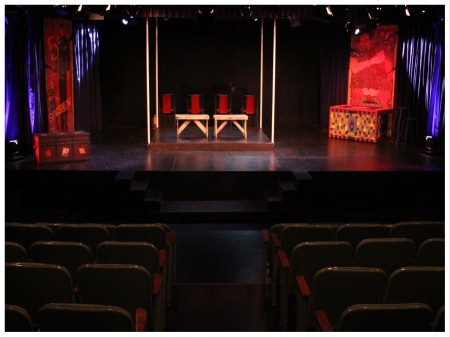 As seen from the center aisle of the house, here is almost the same look but without actors or an audience. The red trunk light has been brought up for this photo. The closeness of each stage element shows the importance of controlling spill light on smaller stages. |
Play in a Day
Bella Rose Arts Centre
Halifax, Nova Scotia
October, 2010
Richard mentored three women
from the law profession to design,
assemble and perform lighting for
a play in support of
The Legal Information Society
of Nova Scotia
|
Lighting here is a single 1000-watt,
26-degree ellipsoidal from front of
house in a light orange colour correction.
Back lighting is a single 1000-watt,
150-mm fresnel with barndoors. The colour
is a steel blue. |
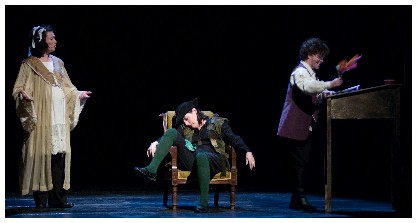 |
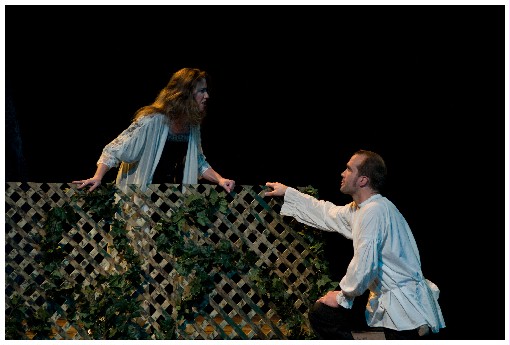 One front of house 1000-watt, 26-degree ellipsoidal provides key lighting here. It is in a dark steel blue with a foliage pattern to give texture. The medium blue colour is from two 1000-watt, wide-flood, front-of-house PAR 64s. A single fresnel above and behind Juliette provides warm back lighting. It shines on to her hair and continues on to light Romeo's face as candle light from Juliette's room might. This light was also textured by shining it through the upstage lighting catwalk's steel-grid floor. |
|
A single 1000-watt, 26-degree ellipsoidal
from the front of house lights the cast
members. It has no colour. Back light
comes from the same fresnel as used in
the "Shakespeare" photo. |
 |
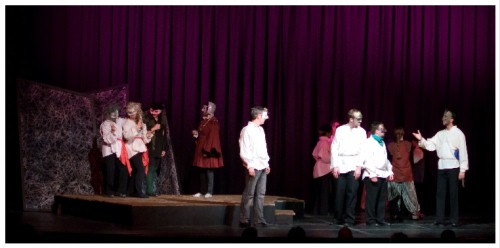 The main stage is in red while the curtain has a deep pink which looks lavender here. All are from wide-flood PARs. The principles are lit by two 37-degree ellipsoidals with no colour. |
|
Thanks go to photographers Ian Flemming, Colin Conrad and Bruce
Goodick of Dartmouth, and to
Mitch Ward
of Halifax for usage of their photos. |
|
Return to the |
Return to the |
|
Go to the |
|